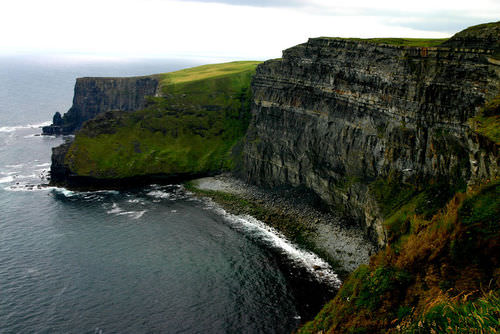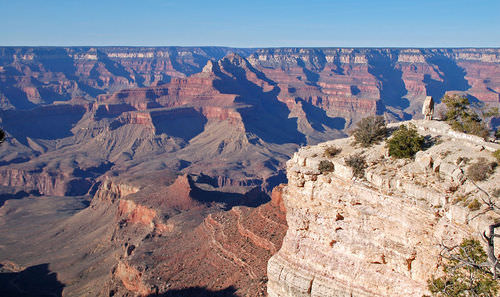15.5: Principles of Relative Dating
- Page ID
- 5579
\( \newcommand{\vecs}[1]{\overset { \scriptstyle \rightharpoonup} {\mathbf{#1}} } \)
\( \newcommand{\vecd}[1]{\overset{-\!-\!\rightharpoonup}{\vphantom{a}\smash {#1}}} \)
\( \newcommand{\id}{\mathrm{id}}\) \( \newcommand{\Span}{\mathrm{span}}\)
( \newcommand{\kernel}{\mathrm{null}\,}\) \( \newcommand{\range}{\mathrm{range}\,}\)
\( \newcommand{\RealPart}{\mathrm{Re}}\) \( \newcommand{\ImaginaryPart}{\mathrm{Im}}\)
\( \newcommand{\Argument}{\mathrm{Arg}}\) \( \newcommand{\norm}[1]{\| #1 \|}\)
\( \newcommand{\inner}[2]{\langle #1, #2 \rangle}\)
\( \newcommand{\Span}{\mathrm{span}}\)
\( \newcommand{\id}{\mathrm{id}}\)
\( \newcommand{\Span}{\mathrm{span}}\)
\( \newcommand{\kernel}{\mathrm{null}\,}\)
\( \newcommand{\range}{\mathrm{range}\,}\)
\( \newcommand{\RealPart}{\mathrm{Re}}\)
\( \newcommand{\ImaginaryPart}{\mathrm{Im}}\)
\( \newcommand{\Argument}{\mathrm{Arg}}\)
\( \newcommand{\norm}[1]{\| #1 \|}\)
\( \newcommand{\inner}[2]{\langle #1, #2 \rangle}\)
\( \newcommand{\Span}{\mathrm{span}}\) \( \newcommand{\AA}{\unicode[.8,0]{x212B}}\)
\( \newcommand{\vectorA}[1]{\vec{#1}} % arrow\)
\( \newcommand{\vectorAt}[1]{\vec{\text{#1}}} % arrow\)
\( \newcommand{\vectorB}[1]{\overset { \scriptstyle \rightharpoonup} {\mathbf{#1}} } \)
\( \newcommand{\vectorC}[1]{\textbf{#1}} \)
\( \newcommand{\vectorD}[1]{\overrightarrow{#1}} \)
\( \newcommand{\vectorDt}[1]{\overrightarrow{\text{#1}}} \)
\( \newcommand{\vectE}[1]{\overset{-\!-\!\rightharpoonup}{\vphantom{a}\smash{\mathbf {#1}}}} \)
\( \newcommand{\vecs}[1]{\overset { \scriptstyle \rightharpoonup} {\mathbf{#1}} } \)
\( \newcommand{\vecd}[1]{\overset{-\!-\!\rightharpoonup}{\vphantom{a}\smash {#1}}} \)
\(\newcommand{\avec}{\mathbf a}\) \(\newcommand{\bvec}{\mathbf b}\) \(\newcommand{\cvec}{\mathbf c}\) \(\newcommand{\dvec}{\mathbf d}\) \(\newcommand{\dtil}{\widetilde{\mathbf d}}\) \(\newcommand{\evec}{\mathbf e}\) \(\newcommand{\fvec}{\mathbf f}\) \(\newcommand{\nvec}{\mathbf n}\) \(\newcommand{\pvec}{\mathbf p}\) \(\newcommand{\qvec}{\mathbf q}\) \(\newcommand{\svec}{\mathbf s}\) \(\newcommand{\tvec}{\mathbf t}\) \(\newcommand{\uvec}{\mathbf u}\) \(\newcommand{\vvec}{\mathbf v}\) \(\newcommand{\wvec}{\mathbf w}\) \(\newcommand{\xvec}{\mathbf x}\) \(\newcommand{\yvec}{\mathbf y}\) \(\newcommand{\zvec}{\mathbf z}\) \(\newcommand{\rvec}{\mathbf r}\) \(\newcommand{\mvec}{\mathbf m}\) \(\newcommand{\zerovec}{\mathbf 0}\) \(\newcommand{\onevec}{\mathbf 1}\) \(\newcommand{\real}{\mathbb R}\) \(\newcommand{\twovec}[2]{\left[\begin{array}{r}#1 \\ #2 \end{array}\right]}\) \(\newcommand{\ctwovec}[2]{\left[\begin{array}{c}#1 \\ #2 \end{array}\right]}\) \(\newcommand{\threevec}[3]{\left[\begin{array}{r}#1 \\ #2 \\ #3 \end{array}\right]}\) \(\newcommand{\cthreevec}[3]{\left[\begin{array}{c}#1 \\ #2 \\ #3 \end{array}\right]}\) \(\newcommand{\fourvec}[4]{\left[\begin{array}{r}#1 \\ #2 \\ #3 \\ #4 \end{array}\right]}\) \(\newcommand{\cfourvec}[4]{\left[\begin{array}{c}#1 \\ #2 \\ #3 \\ #4 \end{array}\right]}\) \(\newcommand{\fivevec}[5]{\left[\begin{array}{r}#1 \\ #2 \\ #3 \\ #4 \\ #5 \\ \end{array}\right]}\) \(\newcommand{\cfivevec}[5]{\left[\begin{array}{c}#1 \\ #2 \\ #3 \\ #4 \\ #5 \\ \end{array}\right]}\) \(\newcommand{\mattwo}[4]{\left[\begin{array}{rr}#1 \amp #2 \\ #3 \amp #4 \\ \end{array}\right]}\) \(\newcommand{\laspan}[1]{\text{Span}\{#1\}}\) \(\newcommand{\bcal}{\cal B}\) \(\newcommand{\ccal}{\cal C}\) \(\newcommand{\scal}{\cal S}\) \(\newcommand{\wcal}{\cal W}\) \(\newcommand{\ecal}{\cal E}\) \(\newcommand{\coords}[2]{\left\{#1\right\}_{#2}}\) \(\newcommand{\gray}[1]{\color{gray}{#1}}\) \(\newcommand{\lgray}[1]{\color{lightgray}{#1}}\) \(\newcommand{\rank}{\operatorname{rank}}\) \(\newcommand{\row}{\text{Row}}\) \(\newcommand{\col}{\text{Col}}\) \(\renewcommand{\row}{\text{Row}}\) \(\newcommand{\nul}{\text{Nul}}\) \(\newcommand{\var}{\text{Var}}\) \(\newcommand{\corr}{\text{corr}}\) \(\newcommand{\len}[1]{\left|#1\right|}\) \(\newcommand{\bbar}{\overline{\bvec}}\) \(\newcommand{\bhat}{\widehat{\bvec}}\) \(\newcommand{\bperp}{\bvec^\perp}\) \(\newcommand{\xhat}{\widehat{\xvec}}\) \(\newcommand{\vhat}{\widehat{\vvec}}\) \(\newcommand{\uhat}{\widehat{\uvec}}\) \(\newcommand{\what}{\widehat{\wvec}}\) \(\newcommand{\Sighat}{\widehat{\Sigma}}\) \(\newcommand{\lt}{<}\) \(\newcommand{\gt}{>}\) \(\newcommand{\amp}{&}\) \(\definecolor{fillinmathshade}{gray}{0.9}\)Where's a good place to see geology?
The Southwestern United States is a fantastic place to see geology. The arid climate means that that the rocks are not covered by vegetation. In many places, especially the national parks, the formations are fantastic. The rocks themselves are very interesting. The principles discussed below are easily seen around the Southwest.
Relative Age Dating
Early geologists had no way to determine the absolute age of a geological material. If they didn't see it form, they couldn't know if a rock was one hundred years or 100 million years old. What they could do was determine the ages of materials relative to each other. Using sensible principles they could say whether one rock was older than another. They could also determine when a process occurred relative to those rocks.
Laws of Stratigraphy
The study of rock strata is called stratigraphy. The laws of stratigraphy can help scientists understand Earth’s past. The laws of stratigraphy are usually credited to a geologist from Denmark named Nicolas Steno. He lived in the 1600s. The laws are illustrated in Figure below; refer to the figure as you read about Steno's laws below.
(a) Original horizontality. (b) Lateral continuity. (c) Superposition.
Law of Superposition
Superposition refers to the position of rock layers and their relative ages (Figure below). Relative age means age in comparison with other rocks, either younger or older. The relative ages of rocks are important for understanding Earth’s history. New rock layers are always deposited on top of existing rock layers. Therefore, deeper layers must be older than layers closer to the surface. This is the law of superposition.
Superposition. The rock layers at the bottom of this cliff are much older than those at the top. What force eroded the rocks and exposed the layers?
Law of Lateral Continuity
Rock layers extend laterally, or out to the sides. They may cover very broad areas, especially if they formed at the bottom of ancient seas. Erosion may have worn away some of the rock, but layers on either side of eroded areas will still “match up.”
The Grand Canyon (Figure below) is a good example of lateral continuity. You can clearly see the same rock layers on opposite sides of the canyon. The matching rock layers were deposited at the same time, so they are the same age.
Lateral Continuity. Layers of the same rock type are found across canyons at the Grand Canyon.
Law of Original Horizontality
Sediments were deposited in ancient seas in horizontal, or flat, layers. If sedimentary rock layers are tilted, they must have moved after they were deposited.
Law of Cross-Cutting Relationships
Rock layers may have another rock cutting across them, like the igneous rock pictured below (Figure below). Which rock is older? To determine this, we use the law of cross-cutting relationships. The cut rock layers are older than the rock that cuts across them.
Cross-cutting relationships in rock layers. The rock layers at the bottom are cut off by the rock layers that are higher up. Which layers are older and which are younger?
Unconformities
Geologists can learn a lot about Earth’s history by studying sedimentary rock layers. But in some places, there’s a gap in time when no rock layers are present. A gap in the sequence of rock layers is called an unconformity.
Look at the rock layers pictured below (Figure below); they show a feature called Hutton’s unconformity. The unconformity was discovered by James Hutton in the 1700s. Hutton saw that the lower rock layers are very old. The upper layers are much younger. There are no layers in between the ancient and recent layers. Hutton thought that the intermediate rock layers eroded away before the more recent rock layers were deposited.
Hutton's discovery was a very important event in geology! Hutton determined that the rocks were deposited over time. Some were eroded away. Hutton knew that deposition and erosion are very slow. He realized that for both to occur would take an extremely long time. This made him realize that Earth must be much older than people thought. This was a really big discovery! It meant there was enough time for life to evolve gradually.
Hutton's unconformity, in Scotland.
Summary
- Sediments are deposited horizontally. This is original horizontality.
- The oldest sedimentary rocks are at the bottom of the sequence. This is the law of superposition.
- Rock layers are laterally continuous.This is the law of lateral continuity.
- Rock B cuts across rock A. Rock A must be older. This is the principle of cross-cutting relationships.
- A gap in a rock sequence is an unconformity.
Review
- How do Steno's laws help geologists to decipher the geological history of a region?
- Why does the principle of lateral continuity work?
- How could you recognize the existence of an unconformity?
Explore More
Use the resource below to answer the questions that follow.
- What is superposition?
- How can the age of the layers be determined?
- How does volcanic ash help scientists to determine the age of a rock sequence?
- What are the radioactive elements?
- If a radiometric age can be determined is there any use for a relative age? Why or why not?







